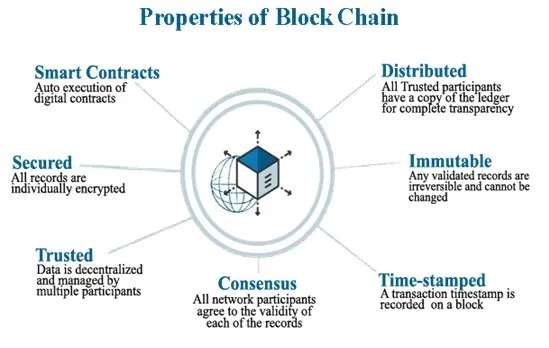Syllabus: GS 3/S&T
In News
- The Ministry of Electronics and Information Technology (MeitY) launched the Vishvasya-Blockchain Technology Stack.
Blockchain Technology
- Blockchain is a shared, immutable ledger that records transactions and tracks assets across a business network.
- It stores information electronically in a digital format to ensure transaction security.
- It is known as Distributed Ledger Technology (DLT).
- It converts and stores anything of value, including currency, in a digital format.
- Historical linkages :It was first proposed in 1991 as a research project, but in the year 2009, Blockchain was used in bitcoin
- Bitcoin is a cryptocurrency which is built on the basis of Block technology.
- Structure and Security: Consists of interconnected data blocks.
- Each block is linked to the previous one, forming a chain.
- Blocks are designed to be secure and resistant to tampering or hacking.

Applications
- Finance and Banking: Financial institution Testing blockchain for trade finance, foreign exchange, cross-border settlement, and securities.
- India, with its large underbanked population, can leverage blockchain for financial inclusion.
- Blockchain has been used in the creation of various cryptocurrencies, decentralized finance applications, non-fungible tokens and smart contracts.
- Governance and Public Services: Blockchain’s potential to enhance transparency and accountability in governance is being actively explored. Applications include land record management, voting systems, and identity verification.
- Healthcare: In healthcare, blockchain can be used to securely manage patient records, ensure data integrity, and facilitate the secure sharing of medical information between institutions.
- Transparent Elections: Blockchain can enhance election processes by providing transparent and tamper-proof voting records.
- Supply Chain Management:Tracking goods from origin to destination becomes more reliable using blockchain.
- India’s vast supply chains can benefit from increased transparency and traceability.
Challenges and Criticisms:
- Lack of Awareness : Despite growing interest, blockchain technology is still at a nascent stage in India.
- Many industries are yet to fully grasp its potential.
- Misconceptions persist, such as the belief that blockchain will replace existing systems entirely.
- Scalability Concerns: Scalability remains a significant challenge.
- Regulatory Uncertainty: Clear regulatory guidelines are essential for widespread adoption.
- India is making progress, but further clarity is needed.
- Cybercrime: Increased crypto adoption has led to a rise in scams and cybercrime.
- India’s nascent regulations make it difficult for victims to recover losses and for authorities to address crypto-related crimes effectively.
Recent Steps
- Vishvasya-Blockchain Technology Stack : It offers Blockchain-as-a-Service with a geographically distributed infrastructure designed to support various permissioned Blockchain based applications.
- National Blockchain Framework :MeitY, with the vision to create trusted digital platforms, initiated National Blockchain Framework (NBF) for promoting research and application development; facilitating state of the art, transparent, secure and trusted digital service delivery to citizens.
- MeitY also unveiled the NBFLite-Lightweight Blockchain Platform, Praamaanik – an innovative blockchain-enabled solution for verifying mobile app origin and National Blockchain Portal.
- Blockchain Sandbox for Startups and Academia: NBFLite, a Blockchain sandbox platform, is developed especially for startups/academia for rapid prototyping of applications, carrying out research and capacity building.
Conclusion and Way Forward
- The Blockchain technology holds immense potential for transforming governance in India by making public services more transparent, efficient, and accountable.
- It has the potential to create new industries and transform existing ones, such as facilitating nano-payments and wealth redistribution.
- As blockchain networks grow, ensuring efficient transaction processing becomes crucial.
- The stakeholders should aim to position India as a global leader in blockchain technology and proliferate the developed solutions for Global adoption, leveraging it to drive economic growth, social development, and digital empowerment.
Source: PIB
Next article
Technical Textiles Will Cross $10 Billion by 2030